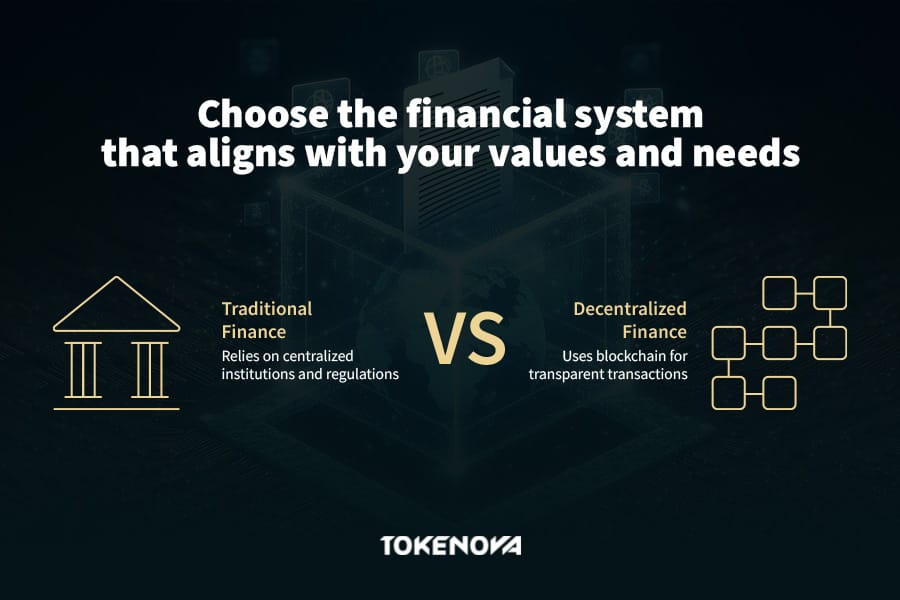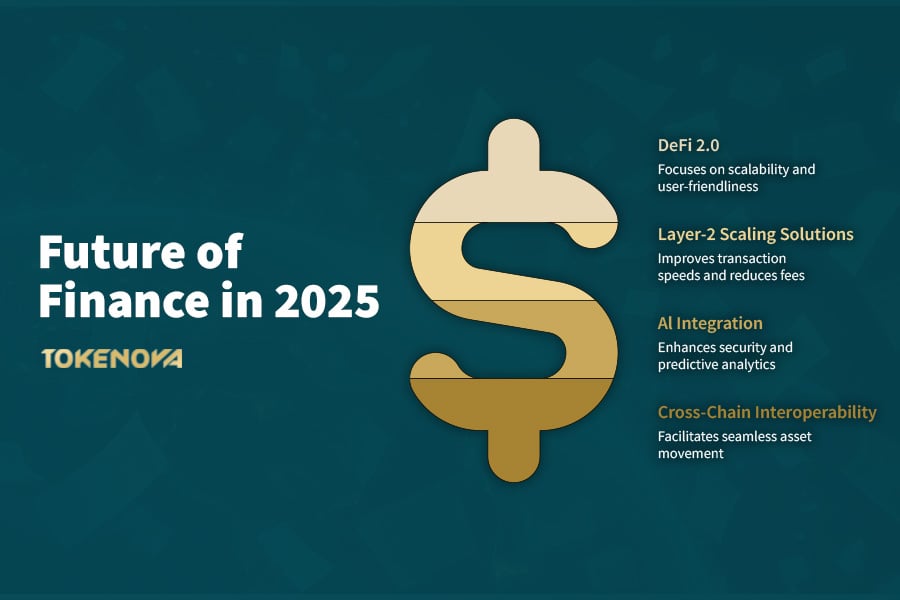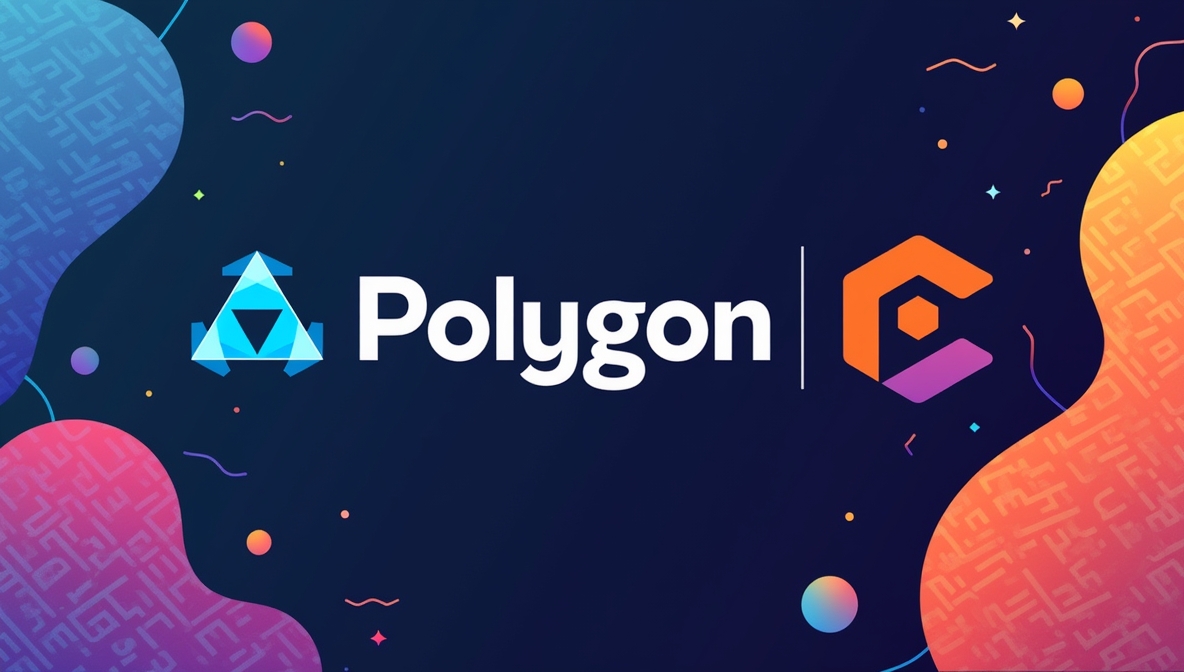Are you ready to explore how finance is changing before our very eyes? In 2025, one of the most talked-about debates revolves around TradFi vs DeFi. The difference between TradFi and DeFi is as stark as it is transformative—one relies on established institutions, while the other brings finance to the digital frontier. Investors, businesses, and everyday people are discovering the massive potential in both systems, each unveiling new ways to save, invest, and transact. This ultimate guide will reveal how Defi and TradFi compare, intertwine, and why their convergence could define the future of global finance.
Understanding the Financial Dichotomy: TradFi vs DeFi and Their Key Difference

To grasp the ongoing transformation in global finance, it’s essential to see why TradFi vs DeFi captures so much attention. Traditional Finance (TradFi) has a long history of relying on centralized institutions, regulations, and trust-based structures. Meanwhile, Decentralized Finance (DeFi) champions blockchain technology to automate transactions and reduce reliance on intermediaries. Below, we unpack this dichotomy and highlight the difference between TradFi and DeFi as two pillars shaping the future of money.
What Is Traditional Finance (TradFi)?
Traditional Finance, commonly known as TradFi, represents the conventional financial system that has powered global economies for centuries. It encompasses various institutions, markets, instruments, and regulations designed to facilitate money flow, investment, and economic expansion.
💲Financial Expert Tip: It’s important not to confuse TradFi with trade finance, which specifically deals with instruments that make trade transactions safer and more efficient. While TradFi represents the broader financial framework, trade finance is focused on mitigating trade-related risks using specialized products like letters of credit and supply chain finance.
Operating on hierarchical structures, traditional financial institutions serve as trusted intermediaries that oversee transactions and ensure regulatory compliance. As a result, confidence in these institutions, plus a well-defined regulatory environment, forms the bedrock of this model.
What Is Decentralized Finance (DeFi)?
Decentralized Finance (DeFi) is a blockchain-based ecosystem that eliminates traditional intermediaries. Instead, it uses smart contracts—self-executing pieces of code—to facilitate transparent, direct financial interactions among users. The difference between TradFi and DeFi is pronounced: DeFi protocols remove the need for centralized authority, replacing it with permissionless networks that allow anyone with an internet connection to participate.
Core principles of DeFi emphasize openness, transparency, and accessibility, forging a path to trustless transactions and decentralized governance. Every transaction is recorded on a public ledger, creating a tamper-resistant, auditable trail.
Market data illustrates DeFi’s explosive growth, with total value locked (TVL) reaching $214 billion by the end of 2024, marking a 211% surge. DeFi tokens also soared, peaking at a $152 billion market cap before retreating to $102 billion. Projections suggest even further growth, possibly hitting $52.37 billion by 2032, thanks to a CAGR of 9.06%.
TradFi vs DeFi: A Comprehensive Comparison
Before we dive into the specifics, it’s useful to understand how these two systems stack up when placed side by side. By looking at governance models, accessibility, trust mechanisms, and cost structures, we can fully appreciate the difference between TradFi and DeFi and why both hold unique advantages in the modern financial sphere.
Centralization vs. Decentralization
Among the most evident difference between TradFi and DeFi is the governance model. TradFi remains centralized, entrusting financial control to large institutions. These firms often have vertical structures where pivotal decisions are made by a select group. Conversely, DeFi disperses authority across a network of participants, removing single points of failure and leveraging automated smart contracts. This approach fosters transparency and lowers the risk of manipulation.
Accessibility and Inclusion
TradFi, though robust, can create barriers to entry: geographical constraints, minimum balances, credit checks, and complex documentation can all exclude vast segments of the population. DeFi’s permissionless nature breaks down these hurdles, allowing anyone with an internet connection to join. This could potentially revolutionize global finance by extending services to the 1.7 billion unbanked adults around the world.
Transparency and Trust Mechanisms
Institutional trust underpins TradFi. Users rely on the reputation, historical performance, and regulatory compliance of established entities. Yet, detailed workings often remain opaque, from fee structures to investment decisions. In contrast, DeFi champions radical transparency, with transactions recorded on a public blockchain. Open-source smart contracts undergo community audits, shifting trust from centralized bodies to cryptographic proofs and consensus algorithms.
Efficiency and Cost Structures
Multilayered intermediaries make TradFi transactions costlier and slower—international transfers can take days and rack up fees. Compliance, physical infrastructure, and overhead further inflate costs. DeFi reduces friction through automation, enabling near-instant settlements at a fraction of the cost, particularly for cross-border dealings. Smart contracts streamline processes, removing reliance on middlemen and creating a leaner, more efficient system.
Innovation Velocity
TradFi’s tightly regulated environment can hamper rapid innovation. Financial products require rigorous testing, regulatory checks, and cautious rollouts. While this ensures stability, it can stall adaptability. DeFi, on the other hand, evolves swiftly thanks to its open, permissionless ethos. Protocols can be launched or updated without waiting for institutional green lights. The composable design of DeFi—often likened to “money legos”—allows for novel financial instruments to appear at breakneck speed.
The Convergence of TradFi and DeFi in 2025
Having explored their differences, let’s look at how these two financial models are increasingly merging. Pitting TradFi against DeFi used to spark debate over which would dominate, but the reality shows a growing inclination toward integration. Below are pivotal ways TradFi and DeFi converge to form hybrid financial ecosystems that benefit individuals, institutions, and broader markets.
Institutional Adoption of DeFi
By 2025, financial giants worldwide are embracing DeFi, recognizing its potential for improved efficiency, cost savings, and transparency. JPMorgan’s Onyx platform is a prime example, employing blockchain for institutional transactions.
Real-World Asset Tokenization
Tokenizing real-world assets (RWAs) is a game-changer at the intersection of TradFi and DeFi. By converting commodities, real estate, or stocks into digital tokens on a blockchain, platforms can provide fractional ownership, enhanced liquidity, and transparent trading. The Real-World Asset (RWA) tokenization market is projected to reach $50 billion by the end of 2025, with long-term forecasts suggesting exponential growth to $30 trillion by 2030 as adoption accelerates across real estate, commodities, and private credit sectors. This potential for bridging physical and digital assets exemplifies how the difference between TradFi and DeFi can be leveraged for synergy, not division.
Regulatory Developments
Regulators are catching up to the DeFi phenomenon. In 2025, they collaborate more with tech innovators, aiming to create guidelines that preserve DeFi’s creative spirit while protecting consumers. The Monetary Authority of Singapore (MAS) leads in shaping regulatory approaches that help unify traditional and decentralized finance. This clarity benefits institutional players who otherwise hesitated due to ambiguous rules, leading to accelerated adoption across the board.
Hybrid Financial Products
TradFi and DeFi are not strictly at odds; they’re blending into hybrid financial products. Examples include DeFi lending protocols implementing traditional credit underwriting methods, tokenized bonds representing existing TradFi instruments, and stablecoins bridging fiat and crypto. These mixed models harness the transparency and efficiency of DeFi with the trust and familiarity of TradFi, promising a new frontier in financial services.
Key Trends Shaping the Future of Finance in 2025

With both TradFi and DeFi evolving rapidly, it’s crucial to keep an eye on the trends steering this transformation. These developments include technology upgrades, regulatory shifts, and market expansions.
DeFi 2.0 and Enhanced Functionality
DeFi continues evolving with a “2.0” wave. Projects aim to address earlier shortcomings like high fees, security vulnerabilities, and steep learning curves. New protocols emphasize scalability, user-friendly interfaces, and robust governance. By integrating advanced risk management and multi-chain interoperability, DeFi 2.0 platforms attract both retail users and institutional investors, steadily blurring lines between traditional and decentralized finance.
Layer-2 Scaling Solutions
High network congestion once hindered DeFi’s real-world usability, but Layer-2 solutions in 2025 dramatically improve transaction speeds and reduce fees. Technologies like rollups and sidechains process data off the main chain before finalizing on a secure network, making DeFi transactions far more efficient. This development lowers barriers to entry, enabling broader use cases—from micro-loans to automated high-frequency trading.
AI Integration in Financial Services
Artificial intelligence is a transformative force across both TradFi and DeFi. In decentralized ecosystems, AI-driven platforms help with tasks like algorithmic trading, loan underwriting, and predictive analytics. Machine learning models can detect fraudulent activities more effectively, enhancing security in a trust-minimized environment. As AI matures, expect further convergence of data analytics, blockchain technology, and DeFi protocols, potentially revolutionizing how financial products are designed and offered.
Cross-Chain Interoperability
With multiple blockchains now hosting DeFi applications, seamless cross-chain interoperability is crucial for a cohesive user experience. Protocols that link disparate networks expand the liquidity pool and utility of DeFi, sparking new collaborations and reducing fragmentation. This includes bridging solutions for tokenized assets, making it easier to move capital between traditional markets and DeFi protocols. The outcome? A more unified financial ecosystem, merging stability and innovation like never before.
Risks and Challenges in the Evolving Financial Landscape
No transformation comes without hurdles. It’s essential to understand these risks to navigate the merging financial terrain safely and effectively.
Security Concerns
Security remains a shared priority for both TradFi and DeFi, albeit with distinct vulnerabilities. TradFi deals with centralized points of failure and insider threats, while DeFi confronts smart contract exploits, oracle manipulation, and flash loan attacks. As each domain borrows from the other, a holistic security framework is essential. Self-regulating practices and advanced auditing tools are likely to continue making DeFi safer, thus encouraging institutional participation.
Regulatory Uncertainty
Despite progress, legal ambiguities persist. Different jurisdictions vary in their approach to regulating DeFi, posing challenges for businesses straddling TradFi and DeFi. Striking a balance between fostering innovation and ensuring consumer protection is an ongoing struggle. The final outcomes will shape how quickly these two systems can converge.
Adoption Barriers
DeFi must overcome usability issues, from intricate user interfaces to confusing wallet setups, for mainstream acceptance. Education is another concern, as many potential users remain skeptical or unaware of decentralized finance’s capabilities. Meanwhile, traditional institutions face challenges integrating with blockchain technologies—legacy systems, bureaucratic inertia, and compliance hurdles can slow progress. Overcoming these barriers relies on improved design, better communication, and cooperative efforts between TradFi and DeFi.
Strategic Implications for Investors and Businesses
In this section, we examine how diversified portfolios, innovative business models, and brand positioning can benefit from this shift in financial paradigms.
Diversification Opportunities
Holding both conventional and decentralized assets can balance portfolios by capturing upside in emerging blockchain sectors while retaining established market stability. Tokenization of real-world assets introduces entirely new investment avenues, letting people fractionally own properties or commodities once out of reach. As these worlds draw closer, innovative yield opportunities and risk management tools arise, making cross-system investing more compelling.
Business Model Innovation
Enterprises across industries must adapt to the synergy of TradFi and DeFi. Banks incorporating DeFi could cut operational costs and tap into global liquidity. Crypto startups adopting TradFi elements could bolster user trust, compliance, and legitimacy. This cross-pollination fuels fresh business models that amalgamate decentralized solutions with time-tested financial paradigms.
Building Brand Presence in the Evolving Financial Space
In a crowded digital marketplace, building brand presence is vital. DeFi projects often rely on effective SEO, content marketing, and community engagement to stand out. For conventional banks expanding into decentralized solutions, transparent communication and user education foster trust. Tactics might include publishing clear documentation, offering user-friendly platforms, and highlighting success stories to ease concerns and prove credibility.
Which Will Dominate: TradFi or DeFi?
Having looked at the successes and challenges, it’s natural to ask if one model will outshine the other. Many experts argue that the TradFi-DeFi comparison shouldn’t be viewed as a zero-sum game. Instead, the two can complement each other, capitalizing on their respective strengths in accessibility, trust, and innovation.
Blending Strengths, Not Waging War
Speculation abounds on whether TradFi will ultimately overshadow DeFi, or if DeFi’s technological edge will outpace traditional banking. The truth, however, may lie somewhere in between. Many industry leaders argue that both models will coexist, with each addressing distinct needs while intersecting at key points of innovation and regulatory oversight. TradFi’s century-long establishment provides it with deep trust, regulatory backing, and global reach, whereas DeFi’s agile protocols deliver unparalleled speed, transparency, and accessibility.
Essentially, the difference between TradFi and DeFi does not have to spell conflict. Instead, it can fuel a new financial paradigm in which established institutions leverage decentralized platforms to expand services to unbanked regions or develop more cost-effective lending programs. Simultaneously, DeFi platforms might incorporate robust TradFi compliance standards and risk assessments to attract conservative investors.
Some analysts believe that tokenized assets, bridging solutions, and regulatory clarity will be the final catalysts for DeFi to become a cornerstone of global finance. Others point out that TradFi’s brand recognition and legal infrastructure remain formidable barriers to any new system.
Unlock the Future of Finance with Tokenova
Are you navigating the complexities of TradFi vs DeFi and seeking expert guidance? Tokenova is your trusted partner in decentralized finance consulting and advisory services. We help businesses, investors, and financial institutions leverage blockchain technology for sustainable growth and innovation.
Why Choose Tokenova?
- Expert DeFi Advisory – Gain insights from industry professionals with deep knowledge of decentralized finance, tokenization, and blockchain integration.
- Strategic Consulting – Whether you’re a startup or an established institution, we craft tailored strategies to bridge TradFi and DeFi for maximum impact.
- Regulatory & Compliance Support – Stay ahead of evolving regulations with our in-depth expertise in global DeFi compliance frameworks.
- Tokenization Solutions – Transform real-world assets into blockchain-powered digital securities to unlock new liquidity opportunities.
- Custom DeFi Integration – Build and optimize DeFi applications, smart contracts, and decentralized protocols with confidence.
Take the Lead in Decentralized Finance
Don’t get left behind in the financial revolution. Partner with Tokenova today and take your DeFi strategy to the next level.
Conclusion
In conclusion, it’s clear both Defi and TradFi are merging in ways that redefine global finance. The difference between TradFi and DeFi extends beyond technology, encompassing trust, regulation, and inclusive access. Already, we see real-world asset tokenization and hybrid products bridging the gap, offering broader opportunities for businesses and individuals. Through thoughtful collaboration and informed decision-making, both systems can strengthen each other, amplifying innovation and stability. Rather than viewing TradFi vs DeFi as a rivalry, it’s better to see them as complementary forces. As we look beyond 2025, their integration could shape a future financial ecosystem that is transparent, efficient, and accessible to all.











